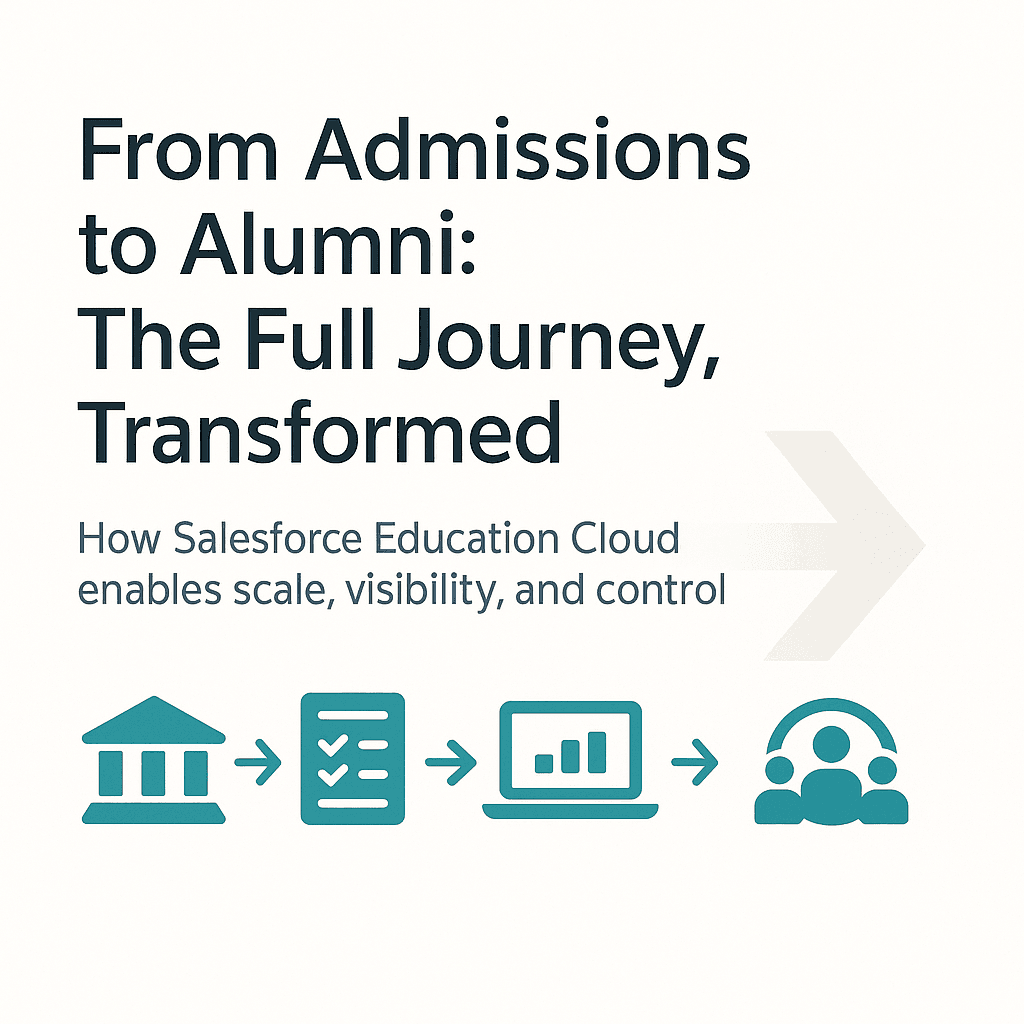From Forms to Futures
For large-scale education networks, student admissions are just the beginning. Once students are enrolled, institutions face a far more complex challenge: managing thousands of individual journeys across multiple campuses, systems, and years.
Unfortunately, this phase is often where digital transformation stops. While admissions may be digitized, onboarding, transfers, academic tracking, and alumni transitions still rely on disconnected tools and manual coordination. The result is operational inefficiency, data blind spots, and limited oversight.
Salesforce Education Cloud offers a more comprehensive approach. It provides the architecture to manage student journeys at scale, ensuring consistency, transparency, and agility across the full lifecycle.
1. The Overlooked Challenges of Lifecycle Management
Many institutions are so focused on admissions that they overlook what happens next. This creates friction and risk in areas like:
Onboarding delays, where students wait weeks for class assignments or transport arrangements.
Transfer requests, which require multi-step approvals and often get lost between offices.
Academic tracking, which is inconsistent across campuses and years.
Lack of central records for behavioral patterns, interventions, or parent interactions.
Disconnected graduation workflows, with alumni data rarely linked to the original student system.
These gaps create more than administrative pain. They weaken student outcomes and reduce institutional accountability.
2. Salesforce as a Student Journey Platform
Salesforce Education Cloud isn’t just a CRM. It acts as a dynamic platform for orchestrating full student journeys not just static records or form-based automation.
With Salesforce, institutions can:
Manage student progression with centralized logic and workflows.
Adapt to regional or category-specific policies without manual intervention.
Gain real-time visibility across zones, branches, and cohorts.
Build an operational memory that grows with the institution.
3. Key Lifecycle Automations Enabled by Salesforce
Onboarding and Orientation
Once a student is admitted, Salesforce can trigger a sequence of onboarding activities:
Send welcome emails and campus-specific guides.
Assign students to class sections based on capacity and policy.
Launch verification workflows for critical documents.
Transfers and Promotions
Transfers between campuses or grade promotions can follow rule-driven flows:
Validate eligibility based on attendance, performance, or parent requests.
Route approvals to the appropriate branch or regional office.
Automatically migrate student history and records.
Academic Performance Monitoring
Salesforce provides a longitudinal view of each student’s academic journey:
Track marks, attendance, and behavioral inputs over time.
Identify students at risk and trigger intervention workflows.
Maintain consistent performance records even after transfers.
Parent and Stakeholder Communication
Institutions can manage all engagement touchpoints in one place:
Log calls, SMS, meetings, and grievances in a unified timeline.
Offer portals or mobile access for real-time updates.
Collect and analyze parent feedback with built-in tools.
Exit and Alumni Transition
When students graduate or leave, Salesforce ensures clean exits:
Route transfer certificate (TC) approvals digitally.
Offer alumni onboarding or optional engagement pathways.
Archive student history in an accessible, audit-friendly format.
4. Building Institutional Memory and Visibility
Data doesn’t just inform reporting. It powers decisions. With Salesforce dashboards, HQ and regional leaders can access:
Retention and dropout metrics across zones.
Student movement trends across branches.
Early indicators of disengagement or performance decline.
Effectiveness of previous interventions.
This turns raw student data into actionable intelligence.
5. No Need to Start from Scratch
Salesforce Education Cloud works with existing systems. Institutions do not need to replace their entire tech stack. Instead, they can:
Connect with national platforms like e-Counselling or SAMAGAM.
Sync academic data with SIS and ERP tools.
Integrate transport, biometric, or ID systems through APIs.
Transformation becomes incremental and manageable, not disruptive.
6. Why Lifecycle Management Matters Now
Education networks that serve tens or hundreds of thousands of students cannot afford gaps in visibility or control. When student records are fragmented, policies are inconsistently applied and students fall through the cracks.
Managing the full lifecycle ensures:
Better outcomes for students and parents.
Stronger compliance with government or public mandates.
Greater agility when scaling operations.
Salesforce offers a single platform to bring all of this together.
Ready to Go Beyond Admissions?
If your institution has already modernized admissions, the next step is clear. Let’s reimagine the entire student lifecycle from onboarding to alumni with the same intelligence, automation, and scale.




